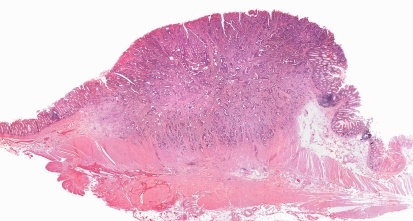Gain new perspectives for faster progress directly to your inbox.
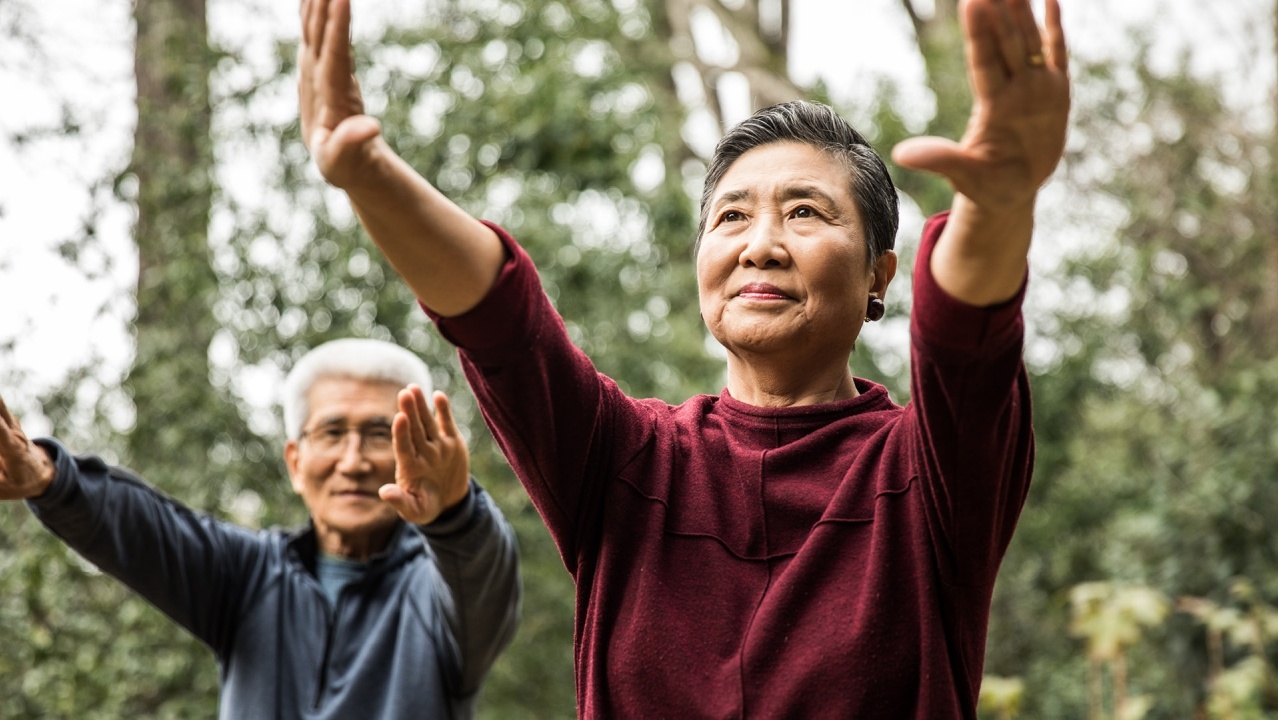
Throughout history, humans have been intrigued by the aging process and have attempted to understand and combat it. For example, ancient Chinese medicine included herbal remedies and acupuncture techniques designed to promote health and longevity. A key milestone came in the 1930s when it was discovered that caloric restriction enhanced lifespan in mice and rats. Further ground-breaking research in the 20th century explored the role of factors such as genetics and cellular senescence.
CAS has identified more than 500,000 scientific articles (mainly journal articles and patents) relating to aging physiology and anti-aging strategies. There has been a steady growth in these articles over time, with research efforts intensifying in the last decade (Figure 1).
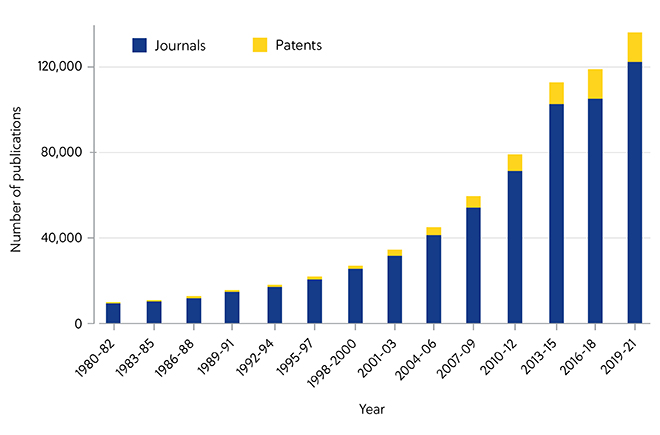
The trend in anti-aging research is showing no signs of slowing down. The World Health Organization (WHO) estimates that by 2050, the world’s population of people aged 60 years and older will exceed 2 billion. This demographic shift towards an older population has spurred increased interest and investment in anti-aging research to address age-related diseases and promote healthy aging. The United Nations (UN) General Assembly declared 2021–2030 the UN Decade of Healthy Ageing, a program promoting global collaboration to find interventions that can extend health span and improve quality of life for older individuals.
While aging is a risk factor for many chronic diseases, there is interest in promoting "successful aging" by focusing on overall health and wellbeing. In this article, we delve into the aging process, exploring a diverse range of interventions aimed at promoting successful aging and longevity. Which of these anti-aging treatment strategies hold the most promise for promoting successful aging?
Aging: Not just skin deep
The term "anti-aging" often evokes thoughts of visible signs of skin aging like wrinkles and sagging. Skin aging is extensively studied due to its social and psychological impacts. As the body's largest organ, the skin plays a vital protective role against environmental factors. With age, the skin's ability to fulfill this function can diminish, affecting overall health. Although skin aging is a natural process, measures can be taken to slow it and maintain skin health. The cosmetics and skincare industries, including companies like L'Oreal and Amorepacific, have a significant interest in this area, holding numerous patents in the field. These products feature ingredients like hyaluronic acid or vitamin E, which affect the surface layers of the skin.
The process of aging is far more complex than what we see on the surface. Aging is broadly defined as a gradual functional decline in a living organism’s intrinsic ability to defend, maintain, and repair itself to keep working efficiently. The brain is particularly sensitive to the effects of aging, causing changes in its size, vasculature, and cognition. This puts us at increased risk of developing certain neurological disorders as we age such as Alzheimer’s disease.
Aging is also characterized by a gradual loss of physiological fitness that affects the entire body, leading to deteriorated functions and enhanced vulnerability. Although aging alone is not the direct cause of serious ailments like cancer, diabetes, and cardiovascular disorders, it serves as a significant risk factor for these conditions and numerous others. Consequently, the recognition of this connection has brought the rapidly growing field of aging research to the forefront.
The hallmarks of aging
Aging is essentially the accumulation of damage over time, leading to specific physiological changes known as the hallmarks of aging. In 2013, nine molecular and cellular hallmarks of aging were defined, providing a framework for future research. These hallmarks include genomic instability, telomere attrition, epigenetic alterations, loss of proteostasis, dysregulated nutrient sensing, mitochondrial dysfunction, cellular senescence, stem cell exhaustion, and altered intercellular communication (Figure 2).
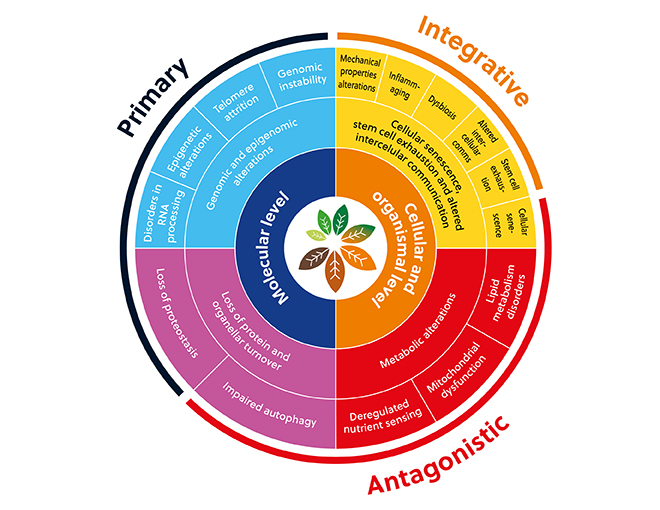
To complicate matters further, the different hallmarks of aging are interconnected and can contribute to each other (Figure 3). In fact, these hallmarks are so intertwined that some researchers propose that we should instead consider aging as a process that operates in four layers, each at a different biological scale. However, as we consider aging, it’s clear that understanding the relationships between these different hallmarks can help in developing effective interventions to prevent or treat age-related diseases.
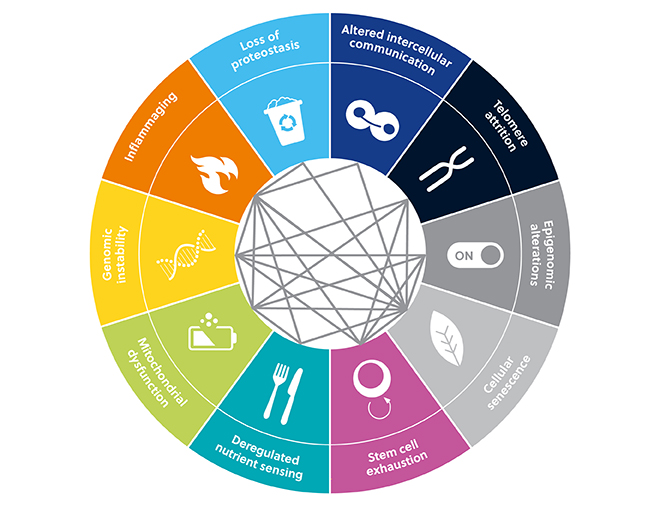
What are the most promising anti-aging treatment strategies?
A variety of anti-aging treatment strategies targeting the hallmarks of aging have been explored, many of which have been targeted to multiple hallmarks (Figure 4). Here’s an overview of five such interventions, and the current evidence for each approach to determine which of them hold the most potential.
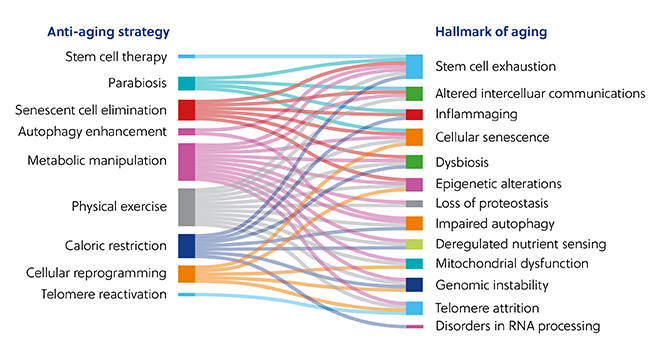
Physical exercise exhibits a significant anti-aging impact at a cellular level, related to each and every aging hallmark. Research on physical exercise as an intervention for aging indications is well established and clinical trials are seeing promising results. Notable ongoing trials are exploring the effects of physical exercise on Alzheimer’s disease, unsteady gait, cognitive function, and post-traumatic stress disorder (Table 1).
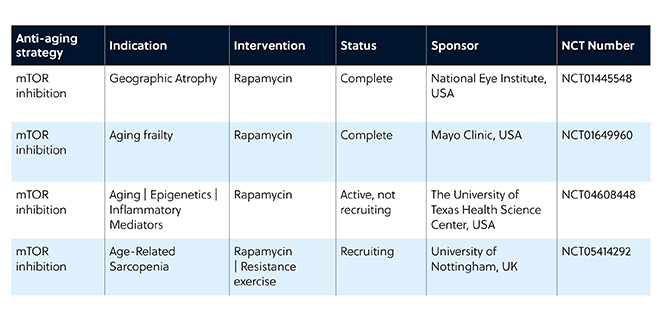
Dietary intervention as anti-aging strategy
Recently, two related dietary interventions, caloric restriction and intermittent fasting, have been reported to effectively prolong the healthy lifetime of the nervous system by affecting basic metabolic and cellular signaling pathways that regulate longevity. Although this approach has proven successful in animal models, caloric restriction is a difficult strategy to apply in humans, as it requires a high level of determination and self-control. An alternative route is to emulate its effects using ‘caloric restriction mimetics’. Like physical exercise, caloric restriction is a well-researched anti-aging treatment strategy with several clinical trials currently underway (Table 2).
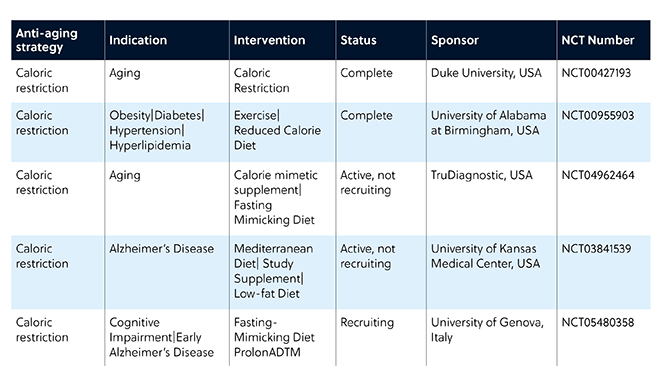
Metabolic manipulation as an anti-aging strategy
The mammalian target of rapamycin (mTOR) signaling pathway has been identified as a significant participant in cellular metabolism that associates nutrient sensing with critical cellular processes that energize cell growth and proliferation. mTOR inhibition with agents such as rapamycin is widely explored in anti-aging clinical trials in a range of indications from aging frailty to age-related sarcopenia (Table 3).

Senotherapy as an anti-aging strategy
Senotherapy involves the development of potential therapeutic agents and approaches to explicitly target cellular senescence, a condition associated with aging and age-associated pathologies. Researchers are investigating several senotherapeutic strategies. A particularly exciting pharmacological strategy is the use of senolytics, which are small molecules that can selectively eliminate senescent cells that are causative of multiple age-related disorders. Targeting aging cells in this way is already being evaluated in clinical trials (Table 4).
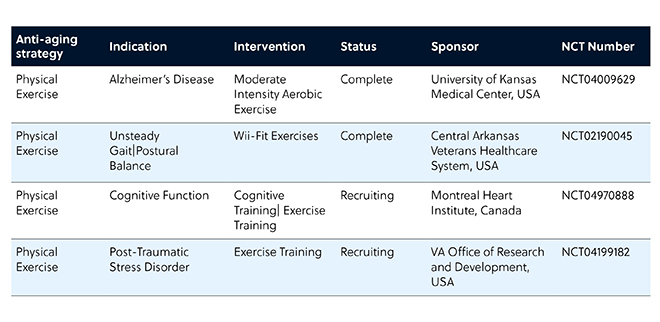
Cellular reprogramming as an anti-aging strategy
Is it possible to turn back the clock at a cellular level? Cellular reprogramming aims to do exactly this by converting terminally differentiated mature cells into induced pluripotent stem cells. By reprogramming cells in this way, we can effectively ameliorate several hallmarks of aging such as mitochondrial dysfunction, telomere attrition, changes in epigenetic alterations, genomic instability, and senescence. Though research is still in the early stages, this approach has shown promise in preclinical models.
By tackling the challenges of an aging population head-on, anti-aging research holds the promise of transforming the way we age, enhancing our overall wellbeing, and fostering a healthier and more vibrant global community.
To learn more about the exciting and dynamic field of anti-aging research, read our latest journal manuscript here.

